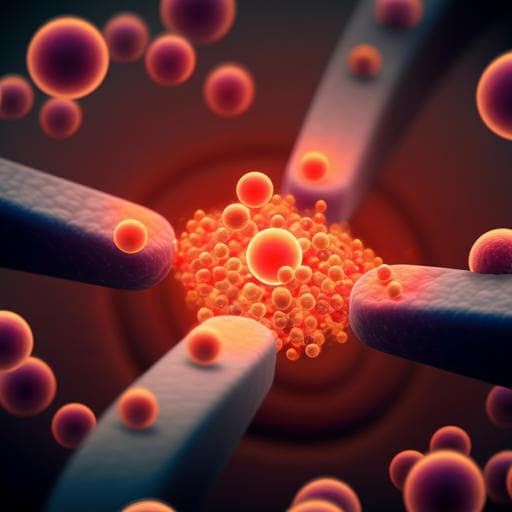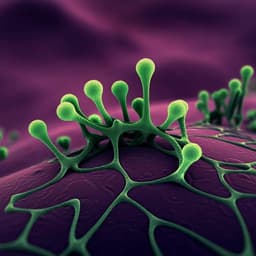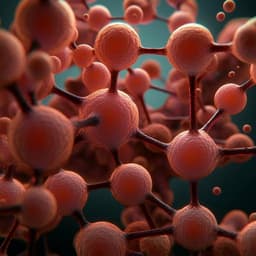
Medicine and Health
A 3D-printed magnetic digital microfluidic diagnostic platform for rapid colorimetric sensing of carbapenemase-producing Enterobacteriaceae
P. Kanitthamniyom, P. Y. Hon, et al.
Discover MDM Carba, an innovative magnetic digital microfluidic platform for the rapid identification of drug-resistant carbapenemase-producing Enterobacteriaceae. Conducted by a team of researchers including Pojchanun Kanitthamniyom and Pei Yun Hon, this groundbreaking study showcases an automated and efficient method that enhances diagnostics in challenging clinical environments.
~3 min • Beginner • English
Introduction
Infectious diseases remain a leading cause of mortality worldwide, and the growing threat of antimicrobial resistance undermines the effectiveness of antibiotics. Gram-negative pathogens, including carbapenemase-producing Enterobacteriaceae (CPE), are of particular concern due to increasing prevalence, panresistance, and high morbidity and mortality. CPE produce carbapenemase enzymes that hydrolyze carbapenems, often last-line agents. Rapid identification of CPE can guide timely clinical decisions, including use of last-resort therapies, and distinguishing resistance mechanisms is increasingly important for optimizing antimicrobial therapy. Conventional phenotype-based CPE assays (e.g., modified Hodge test, modified carbapenem inactivation method) are time-consuming (16–24 h) and may have suboptimal accuracy or specificity, while nucleic acid tests can be costly, resource-intensive, and limited to predefined targets. Many phenotypic platforms detect resistance but not mechanism, limiting their utility for CPE detection. The Carba NP test (2012) offers a rapid chromogenic method (~2 h) to detect carbapenemase activity but still relies on manual liquid handling. This work introduces magnetic digital microfluidics (MDM) to miniaturize and parallelize the Carba NP assay. MDM discretizes liquids into droplets and performs merging, mixing, dispensing, and dilution using magnetic particles and fields, avoiding pumps and valves and enabling simplified automation. Compared with electrowetting-on-dielectrics (EWOD), MDM is less efficient in manipulation/automation but is advantageous for biochemical reactions and point-of-care diagnostics due to simplicity and dual-function magnetic particles. Building on prior 3D-printed modular MDM platforms, the authors develop MDM Carba to deliver rapid, accurate, and parallel CPE detection with up to 90% reagent reduction, automated or manual operation, and potential for resource-limited settings.
Literature Review
The study builds on the Carba NP assay, a rapid chromogenic test detecting carbapenemase activity via pH change upon imipenem hydrolysis. Conventional phenotype-based methods (modified Hodge test, mCIM) require 16–24 h and can have specificity limitations. Molecular assays (PCR) are expensive and target-limited. Prior microfluidic approaches, including continuous-flow microfluidics for Carba NP and digital microfluidics via EWOD, have been explored; however, continuous-flow systems require pumps/valves and EWOD, while efficient, can be less suitable for simple POC use. MDM technology has been demonstrated for sample-to-answer molecular testing, immunoassays, and broth microdilution antimicrobial susceptibility testing, supporting its suitability for in vitro diagnostics and motivating its application to CPE detection.
Methodology
Assay principle: The platform implements the Carba NP assay, which detects carbapenemase activity by a colorimetric pH shift (phenol red indicator). Lysis buffer is colorless; reaction buffer (phenol red with Zn2+ at pH 7.8) is red. Carbapenemase-mediated imipenem hydrolysis lowers pH, changing droplet color from red to yellow/orange (positive). A paired control reaction without imipenem must remain red for validity. Yellow or orange is recorded positive; red is negative.
Device architecture: The MDM Carba device comprises (1) a base plate with an array of NdFeB magnets; (2) a Teflon AF-coated glass substrate (48 × 65 × 0.15 mm) for low-friction droplet motion; and (3) a 3D-printed translucent top droplet manipulator (54 × 69 × 6.2 mm) featuring 12 functional units enabling 12 parallel reactions—six test units (A+I) and six control units (A). Each unit includes: a sample access port with tip stopper, a micropillar-based passive mixer, a reagent access port, and an observation window with a semicircular hydrophilic droplet holder (polydopamine-coated). The manipulator-substrate gap is tuned to droplet height.
Reagents and droplet preparation: Using a multichannel micropipette, reagents are loaded via access ports aligned with magnets. For each reaction unit: 10 µL lysis buffer (B-PER II) + 3.5 µL magnetic particles (MagAttract Suspension G) form the sample droplet. Reaction buffers: Solution A = 0.5% w/v phenol red + 10 mM ZnSO4, pH 7.8 (0.1 N NaOH). For test units (A+I), Solution A contains 12 mg/mL imipenem/cilastatin (6 mg/mL imipenem). For control units (A), no imipenem is added. Bacterial colonies are picked with a 200-µL tip; the tip is inserted through the sample port to the stopper to contact the sample droplet and incubated 5 min for lysis.
Droplet volumes and constraints: Typical droplet volume per reagent/sample is 10 µL; droplets must be >8 µL to engage the mixing pillars effectively. Merged droplets >22 µL can jam between pillars; thus, maximum recommended individual droplet volume is 11 µL.
Manual operation workflow: After lysis, the top manipulator and glass substrate are slid over the magnet array. Magnetic particles anchor droplets to the underlying magnets, enabling relative motion. Steps: (1) Mix sample droplet under micropillar mixer with several back-and-forth passes to lyse and homogenize; (2) Move sample droplet to merge 1:1 with the corresponding reaction buffer droplet (A or A+I); (3) Mix merged droplet under mixer with defined passes; (4) Move merged droplet to the observation window where the hydrophilic droplet holder immobilizes it; (5) Extract magnetic particles from the immobilized droplet to facilitate optical readout; (6) Incubate droplets at room temperature in a humid chamber. Color readouts are recorded at 30, 45, 60, and 120 min.
Automated operation: A motorized variant replaces manual sliding with a stepper-driven linear motion system. Hardware: modified top plate with linear gear rack, spur gear coupled to a 28BYJ-48 unipolar step motor via a socket gear, position sensing via a 10 kΩ potentiometer linked to the motor shaft. Control electronics: Arduino UNO, ULN2003 driver, HC-05 Bluetooth module, 9 V battery. Motion parameters: motor speeds 200/400/600 rpm produce manipulator speeds 3.28/6.57/9.85 mm/s. Software: PC UI (Visual Studio WinForms) and Android app (Java) communicate over USB/Bluetooth to issue sequences of primitives: Move (distance/direction), Mix (number of passes), Wait (duration). Position feedback via potentiometer ensures target location control.
Mixing performance: The micropillar passive mixer achieves ~90% homogeneity after two passes; without the mixer, at least six passes are required. This enhances lysis and reagent/sample mixing efficiency.
Throughput and timing: The device executes 12 reactions in parallel (six samples, each with test and control). The standard sample-to-answer time is ~125 min with readouts at up to 120 min. The total time can be reduced to ~65 min by limiting incubation to 60 min without compromising sensitivity (as observed in the study).
Validation protocol: For each bacterial isolate, run two droplets in the same row: test (A+I) and control (A). Following mixing and incubation, interpret colors: yellow/orange = positive (CPE), red = negative; control must remain red. In the pilot, 27 clinical isolates were tested on MDM Carba and benchmarked against conventional Carba NP and molecular results.
Key Findings
- The MDM Carba platform successfully miniaturized and parallelized the Carba NP assay, enabling 12 simultaneous reactions (six samples with paired controls).
- Reagent consumption was reduced by up to 90% compared with conventional phenotypic testing.
- In a pilot evaluation of 27 bacterial isolates, MDM Carba achieved sensitivity and specificity comparable to the standard Carba NP test (exact percentages not provided in the excerpt).
- Sample-to-answer time was ~125 minutes with readouts at 30, 45, 60, and 120 min; this can be shortened to ~65 minutes by using a 60-minute incubation without compromising sensitivity.
- Both manual (“power-free”) and automated versions functioned reliably; the automated variant provided controlled motion with speeds of 3.28–9.85 mm/s set via a smartphone/PC UI over Bluetooth/USB.
- The micropillar passive mixer yielded ~90% homogeneity in only two passes, improving mixing efficiency over non-mixer configurations (≥6 passes).
- Operational constraints were characterized: effective droplet volumes 8–11 µL per component to avoid mixing inefficiencies or pillar jamming.
- Colorimetric readout criteria were established: yellow/orange as positive, red as negative; controls (no imipenem) remained red when assays were valid.
Discussion
The study addresses the clinical need for rapid, mechanism-specific detection of carbapenemase production in Enterobacteriaceae by translating the Carba NP assay onto a magnetic digital microfluidic platform. By discretizing reactions into droplets and leveraging magnetic manipulation, MDM Carba reduces reagent use, simplifies fluid handling, and enables parallel processing, all of which improve turnaround time and throughput relative to conventional manual workflows. The comparable sensitivity and specificity to Carba NP indicate that miniaturization and magnetic handling preserve assay performance while reducing costs and enabling automation. The ability to operate manually without complex pumps/valves or external power makes the system suitable for point-of-care and resource-limited settings, potentially facilitating earlier infection control and optimized antimicrobial therapy. Automated motion control further standardizes operation, potentially reducing operator variability and facilitating integration into laboratory workflows. The observed mixing efficiency and defined droplet volume constraints inform robust operation and reproducibility. Overall, MDM Carba offers a practical, scalable approach to rapid CPE detection that can accelerate clinical decision-making and stewardship efforts.
Conclusion
MDM Carba is a 3D-printed magnetic digital microfluidic platform that miniaturizes and parallelizes the Carba NP assay for rapid colorimetric detection of carbapenemase-producing Enterobacteriaceae. It demonstrates comparable diagnostic performance to the conventional Carba NP test while reducing reagent consumption and enabling both manual and automated operation. The platform supports 12 concurrent reactions and can deliver results within approximately 65–125 minutes. Its simplicity and “power-free” capability make it promising for point-of-care use in resource-limited settings. The modular nature of MDM Carba suggests it can be adapted with minor modifications to detect other antibiotic resistance mechanisms and extended to additional biochemical assays. Future work should include larger clinical validations, integration of on-device incubation and optical readout, expansion to broader resistance panels, and further ruggedization for field deployment.
Limitations
- Pilot-scale validation with 27 isolates limits the precision of performance estimates and generalizability; larger, diverse clinical cohorts are needed.
- Exact sensitivity and specificity figures are not provided in the excerpt; full performance characterization across different carbapenemase classes would be informative.
- MDM, while well-suited for POC use, is noted to be less efficient than EWOD for droplet manipulation and automation, which may impact certain high-throughput applications.
- Operational constraints on droplet volumes (8–11 µL) and potential droplet jamming between mixing pillars necessitate careful protocol adherence.
- Environmental control (e.g., room temperature incubation and humidification) may influence colorimetric readout consistency and should be standardized for routine use.
Related Publications
Explore these studies to deepen your understanding of the subject.







